OSHA BOS 3401
VerifiedAdded on 2023/03/17
|8
|2114
|48
AI Summary
Find study material and solved assignments for OSHA BOS 3401. Get essays, dissertations, and more at Desklib.
Contribute Materials
Your contribution can guide someone’s learning journey. Share your
documents today.

Running head: OSHA BOS 3401
OSHA BOS 3401
Name of the Student:
Name of the University:
Author note:
OSHA BOS 3401
Name of the Student:
Name of the University:
Author note:
Secure Best Marks with AI Grader
Need help grading? Try our AI Grader for instant feedback on your assignments.
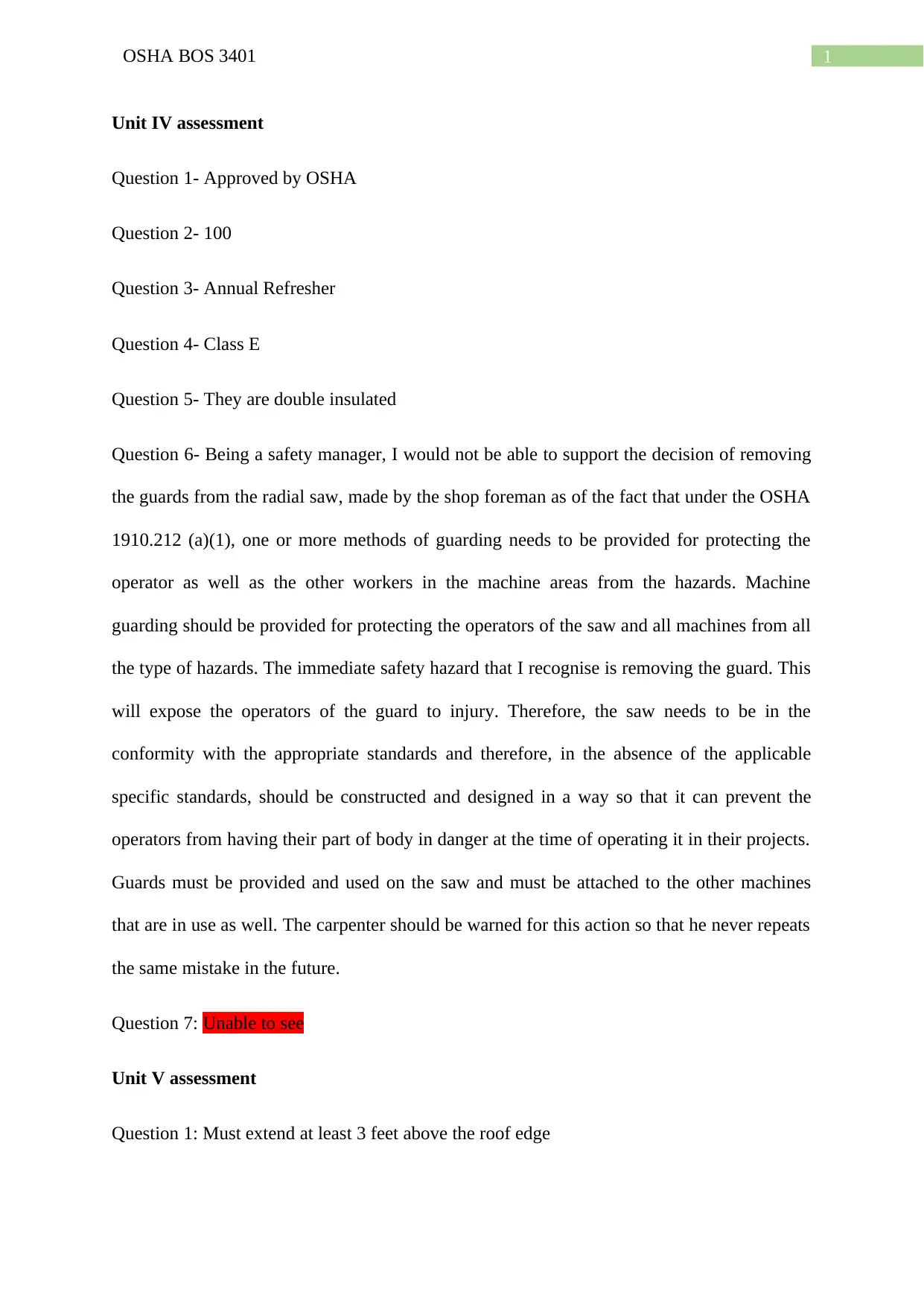
1OSHA BOS 3401
Unit IV assessment
Question 1- Approved by OSHA
Question 2- 100
Question 3- Annual Refresher
Question 4- Class E
Question 5- They are double insulated
Question 6- Being a safety manager, I would not be able to support the decision of removing
the guards from the radial saw, made by the shop foreman as of the fact that under the OSHA
1910.212 (a)(1), one or more methods of guarding needs to be provided for protecting the
operator as well as the other workers in the machine areas from the hazards. Machine
guarding should be provided for protecting the operators of the saw and all machines from all
the type of hazards. The immediate safety hazard that I recognise is removing the guard. This
will expose the operators of the guard to injury. Therefore, the saw needs to be in the
conformity with the appropriate standards and therefore, in the absence of the applicable
specific standards, should be constructed and designed in a way so that it can prevent the
operators from having their part of body in danger at the time of operating it in their projects.
Guards must be provided and used on the saw and must be attached to the other machines
that are in use as well. The carpenter should be warned for this action so that he never repeats
the same mistake in the future.
Question 7: Unable to see
Unit V assessment
Question 1: Must extend at least 3 feet above the roof edge
Unit IV assessment
Question 1- Approved by OSHA
Question 2- 100
Question 3- Annual Refresher
Question 4- Class E
Question 5- They are double insulated
Question 6- Being a safety manager, I would not be able to support the decision of removing
the guards from the radial saw, made by the shop foreman as of the fact that under the OSHA
1910.212 (a)(1), one or more methods of guarding needs to be provided for protecting the
operator as well as the other workers in the machine areas from the hazards. Machine
guarding should be provided for protecting the operators of the saw and all machines from all
the type of hazards. The immediate safety hazard that I recognise is removing the guard. This
will expose the operators of the guard to injury. Therefore, the saw needs to be in the
conformity with the appropriate standards and therefore, in the absence of the applicable
specific standards, should be constructed and designed in a way so that it can prevent the
operators from having their part of body in danger at the time of operating it in their projects.
Guards must be provided and used on the saw and must be attached to the other machines
that are in use as well. The carpenter should be warned for this action so that he never repeats
the same mistake in the future.
Question 7: Unable to see
Unit V assessment
Question 1: Must extend at least 3 feet above the roof edge
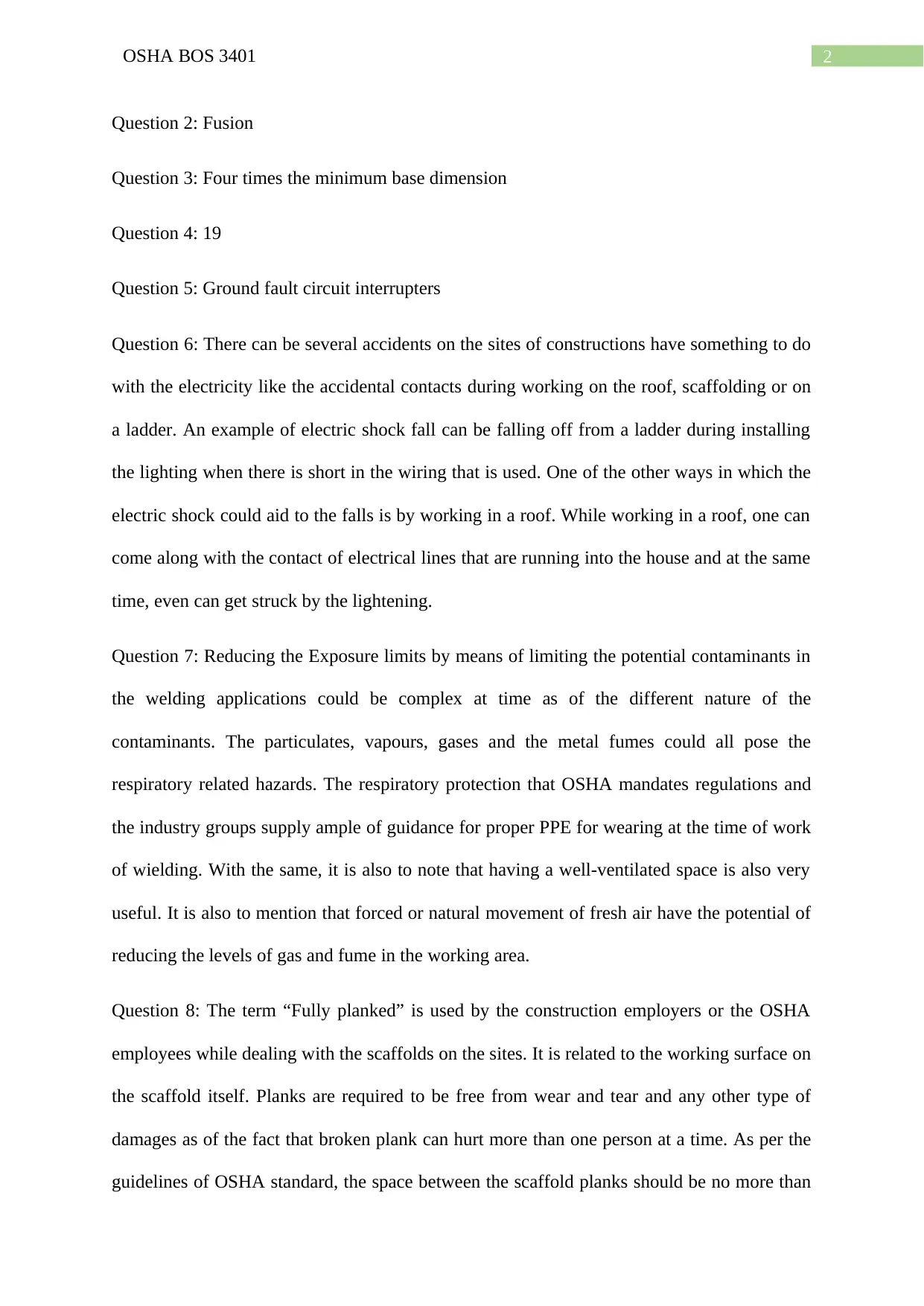
2OSHA BOS 3401
Question 2: Fusion
Question 3: Four times the minimum base dimension
Question 4: 19
Question 5: Ground fault circuit interrupters
Question 6: There can be several accidents on the sites of constructions have something to do
with the electricity like the accidental contacts during working on the roof, scaffolding or on
a ladder. An example of electric shock fall can be falling off from a ladder during installing
the lighting when there is short in the wiring that is used. One of the other ways in which the
electric shock could aid to the falls is by working in a roof. While working in a roof, one can
come along with the contact of electrical lines that are running into the house and at the same
time, even can get struck by the lightening.
Question 7: Reducing the Exposure limits by means of limiting the potential contaminants in
the welding applications could be complex at time as of the different nature of the
contaminants. The particulates, vapours, gases and the metal fumes could all pose the
respiratory related hazards. The respiratory protection that OSHA mandates regulations and
the industry groups supply ample of guidance for proper PPE for wearing at the time of work
of wielding. With the same, it is also to note that having a well-ventilated space is also very
useful. It is also to mention that forced or natural movement of fresh air have the potential of
reducing the levels of gas and fume in the working area.
Question 8: The term “Fully planked” is used by the construction employers or the OSHA
employees while dealing with the scaffolds on the sites. It is related to the working surface on
the scaffold itself. Planks are required to be free from wear and tear and any other type of
damages as of the fact that broken plank can hurt more than one person at a time. As per the
guidelines of OSHA standard, the space between the scaffold planks should be no more than
Question 2: Fusion
Question 3: Four times the minimum base dimension
Question 4: 19
Question 5: Ground fault circuit interrupters
Question 6: There can be several accidents on the sites of constructions have something to do
with the electricity like the accidental contacts during working on the roof, scaffolding or on
a ladder. An example of electric shock fall can be falling off from a ladder during installing
the lighting when there is short in the wiring that is used. One of the other ways in which the
electric shock could aid to the falls is by working in a roof. While working in a roof, one can
come along with the contact of electrical lines that are running into the house and at the same
time, even can get struck by the lightening.
Question 7: Reducing the Exposure limits by means of limiting the potential contaminants in
the welding applications could be complex at time as of the different nature of the
contaminants. The particulates, vapours, gases and the metal fumes could all pose the
respiratory related hazards. The respiratory protection that OSHA mandates regulations and
the industry groups supply ample of guidance for proper PPE for wearing at the time of work
of wielding. With the same, it is also to note that having a well-ventilated space is also very
useful. It is also to mention that forced or natural movement of fresh air have the potential of
reducing the levels of gas and fume in the working area.
Question 8: The term “Fully planked” is used by the construction employers or the OSHA
employees while dealing with the scaffolds on the sites. It is related to the working surface on
the scaffold itself. Planks are required to be free from wear and tear and any other type of
damages as of the fact that broken plank can hurt more than one person at a time. As per the
guidelines of OSHA standard, the space between the scaffold planks should be no more than
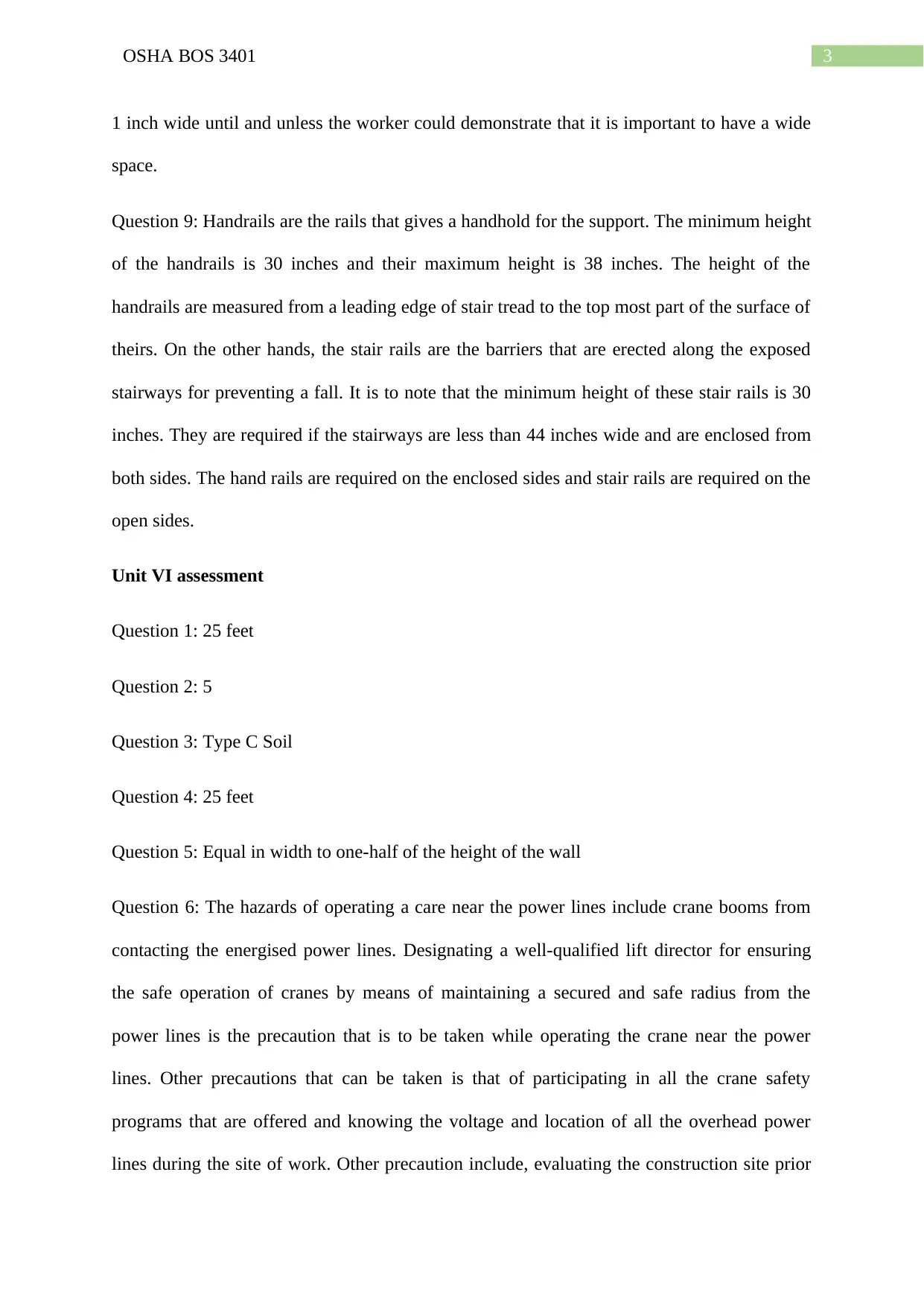
3OSHA BOS 3401
1 inch wide until and unless the worker could demonstrate that it is important to have a wide
space.
Question 9: Handrails are the rails that gives a handhold for the support. The minimum height
of the handrails is 30 inches and their maximum height is 38 inches. The height of the
handrails are measured from a leading edge of stair tread to the top most part of the surface of
theirs. On the other hands, the stair rails are the barriers that are erected along the exposed
stairways for preventing a fall. It is to note that the minimum height of these stair rails is 30
inches. They are required if the stairways are less than 44 inches wide and are enclosed from
both sides. The hand rails are required on the enclosed sides and stair rails are required on the
open sides.
Unit VI assessment
Question 1: 25 feet
Question 2: 5
Question 3: Type C Soil
Question 4: 25 feet
Question 5: Equal in width to one-half of the height of the wall
Question 6: The hazards of operating a care near the power lines include crane booms from
contacting the energised power lines. Designating a well-qualified lift director for ensuring
the safe operation of cranes by means of maintaining a secured and safe radius from the
power lines is the precaution that is to be taken while operating the crane near the power
lines. Other precautions that can be taken is that of participating in all the crane safety
programs that are offered and knowing the voltage and location of all the overhead power
lines during the site of work. Other precaution include, evaluating the construction site prior
1 inch wide until and unless the worker could demonstrate that it is important to have a wide
space.
Question 9: Handrails are the rails that gives a handhold for the support. The minimum height
of the handrails is 30 inches and their maximum height is 38 inches. The height of the
handrails are measured from a leading edge of stair tread to the top most part of the surface of
theirs. On the other hands, the stair rails are the barriers that are erected along the exposed
stairways for preventing a fall. It is to note that the minimum height of these stair rails is 30
inches. They are required if the stairways are less than 44 inches wide and are enclosed from
both sides. The hand rails are required on the enclosed sides and stair rails are required on the
open sides.
Unit VI assessment
Question 1: 25 feet
Question 2: 5
Question 3: Type C Soil
Question 4: 25 feet
Question 5: Equal in width to one-half of the height of the wall
Question 6: The hazards of operating a care near the power lines include crane booms from
contacting the energised power lines. Designating a well-qualified lift director for ensuring
the safe operation of cranes by means of maintaining a secured and safe radius from the
power lines is the precaution that is to be taken while operating the crane near the power
lines. Other precautions that can be taken is that of participating in all the crane safety
programs that are offered and knowing the voltage and location of all the overhead power
lines during the site of work. Other precaution include, evaluating the construction site prior
Secure Best Marks with AI Grader
Need help grading? Try our AI Grader for instant feedback on your assignments.
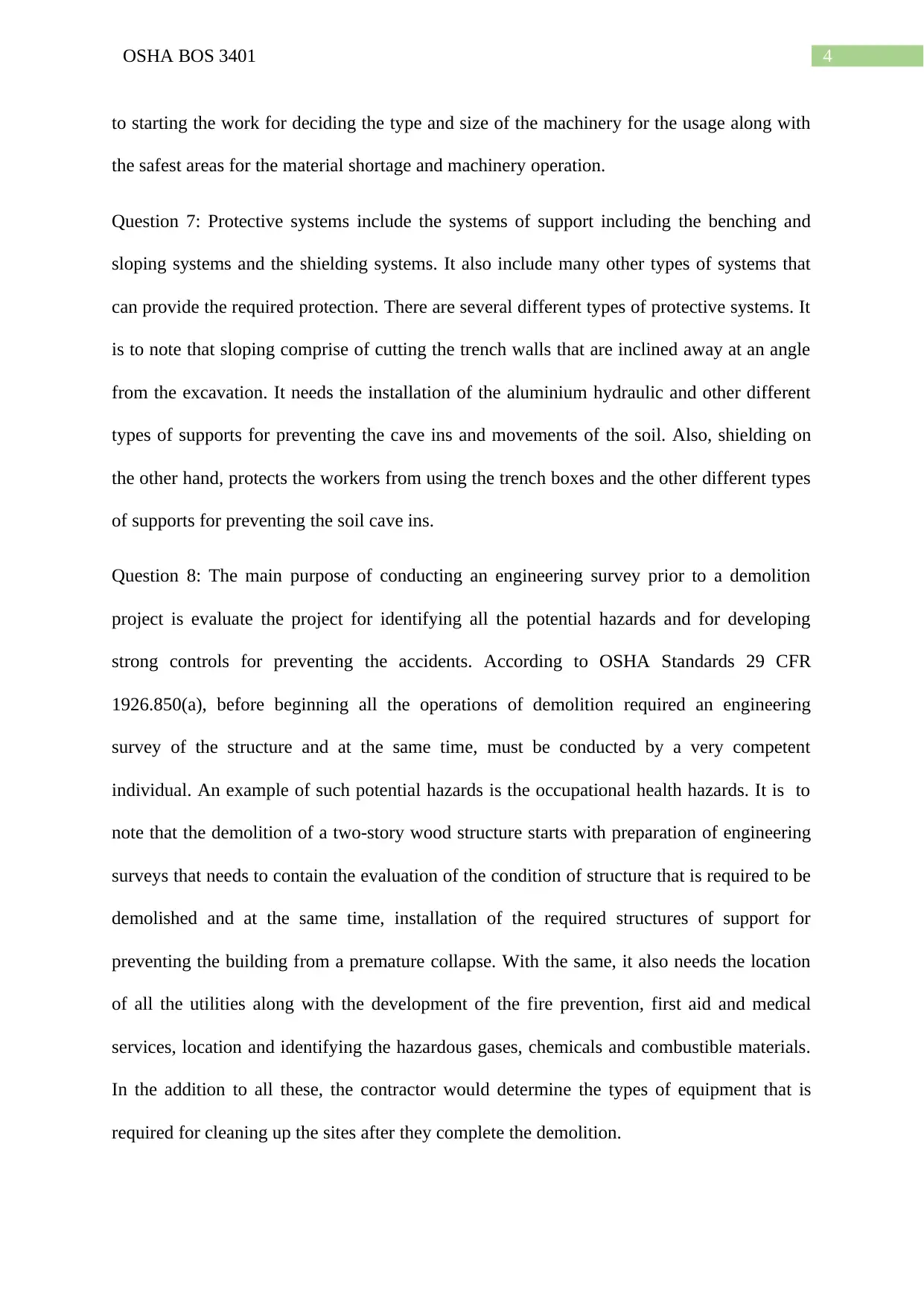
4OSHA BOS 3401
to starting the work for deciding the type and size of the machinery for the usage along with
the safest areas for the material shortage and machinery operation.
Question 7: Protective systems include the systems of support including the benching and
sloping systems and the shielding systems. It also include many other types of systems that
can provide the required protection. There are several different types of protective systems. It
is to note that sloping comprise of cutting the trench walls that are inclined away at an angle
from the excavation. It needs the installation of the aluminium hydraulic and other different
types of supports for preventing the cave ins and movements of the soil. Also, shielding on
the other hand, protects the workers from using the trench boxes and the other different types
of supports for preventing the soil cave ins.
Question 8: The main purpose of conducting an engineering survey prior to a demolition
project is evaluate the project for identifying all the potential hazards and for developing
strong controls for preventing the accidents. According to OSHA Standards 29 CFR
1926.850(a), before beginning all the operations of demolition required an engineering
survey of the structure and at the same time, must be conducted by a very competent
individual. An example of such potential hazards is the occupational health hazards. It is to
note that the demolition of a two-story wood structure starts with preparation of engineering
surveys that needs to contain the evaluation of the condition of structure that is required to be
demolished and at the same time, installation of the required structures of support for
preventing the building from a premature collapse. With the same, it also needs the location
of all the utilities along with the development of the fire prevention, first aid and medical
services, location and identifying the hazardous gases, chemicals and combustible materials.
In the addition to all these, the contractor would determine the types of equipment that is
required for cleaning up the sites after they complete the demolition.
to starting the work for deciding the type and size of the machinery for the usage along with
the safest areas for the material shortage and machinery operation.
Question 7: Protective systems include the systems of support including the benching and
sloping systems and the shielding systems. It also include many other types of systems that
can provide the required protection. There are several different types of protective systems. It
is to note that sloping comprise of cutting the trench walls that are inclined away at an angle
from the excavation. It needs the installation of the aluminium hydraulic and other different
types of supports for preventing the cave ins and movements of the soil. Also, shielding on
the other hand, protects the workers from using the trench boxes and the other different types
of supports for preventing the soil cave ins.
Question 8: The main purpose of conducting an engineering survey prior to a demolition
project is evaluate the project for identifying all the potential hazards and for developing
strong controls for preventing the accidents. According to OSHA Standards 29 CFR
1926.850(a), before beginning all the operations of demolition required an engineering
survey of the structure and at the same time, must be conducted by a very competent
individual. An example of such potential hazards is the occupational health hazards. It is to
note that the demolition of a two-story wood structure starts with preparation of engineering
surveys that needs to contain the evaluation of the condition of structure that is required to be
demolished and at the same time, installation of the required structures of support for
preventing the building from a premature collapse. With the same, it also needs the location
of all the utilities along with the development of the fire prevention, first aid and medical
services, location and identifying the hazardous gases, chemicals and combustible materials.
In the addition to all these, the contractor would determine the types of equipment that is
required for cleaning up the sites after they complete the demolition.
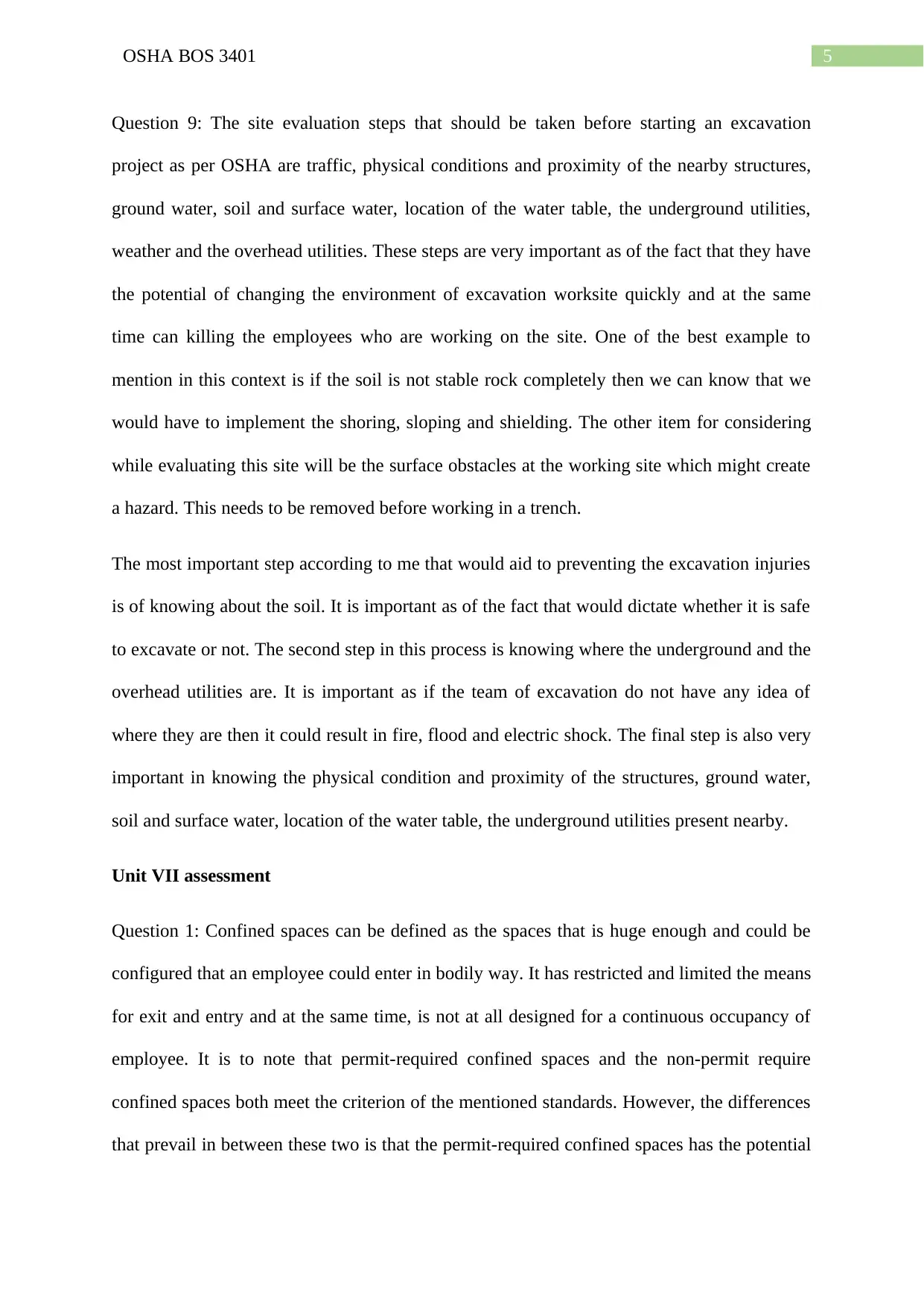
5OSHA BOS 3401
Question 9: The site evaluation steps that should be taken before starting an excavation
project as per OSHA are traffic, physical conditions and proximity of the nearby structures,
ground water, soil and surface water, location of the water table, the underground utilities,
weather and the overhead utilities. These steps are very important as of the fact that they have
the potential of changing the environment of excavation worksite quickly and at the same
time can killing the employees who are working on the site. One of the best example to
mention in this context is if the soil is not stable rock completely then we can know that we
would have to implement the shoring, sloping and shielding. The other item for considering
while evaluating this site will be the surface obstacles at the working site which might create
a hazard. This needs to be removed before working in a trench.
The most important step according to me that would aid to preventing the excavation injuries
is of knowing about the soil. It is important as of the fact that would dictate whether it is safe
to excavate or not. The second step in this process is knowing where the underground and the
overhead utilities are. It is important as if the team of excavation do not have any idea of
where they are then it could result in fire, flood and electric shock. The final step is also very
important in knowing the physical condition and proximity of the structures, ground water,
soil and surface water, location of the water table, the underground utilities present nearby.
Unit VII assessment
Question 1: Confined spaces can be defined as the spaces that is huge enough and could be
configured that an employee could enter in bodily way. It has restricted and limited the means
for exit and entry and at the same time, is not at all designed for a continuous occupancy of
employee. It is to note that permit-required confined spaces and the non-permit require
confined spaces both meet the criterion of the mentioned standards. However, the differences
that prevail in between these two is that the permit-required confined spaces has the potential
Question 9: The site evaluation steps that should be taken before starting an excavation
project as per OSHA are traffic, physical conditions and proximity of the nearby structures,
ground water, soil and surface water, location of the water table, the underground utilities,
weather and the overhead utilities. These steps are very important as of the fact that they have
the potential of changing the environment of excavation worksite quickly and at the same
time can killing the employees who are working on the site. One of the best example to
mention in this context is if the soil is not stable rock completely then we can know that we
would have to implement the shoring, sloping and shielding. The other item for considering
while evaluating this site will be the surface obstacles at the working site which might create
a hazard. This needs to be removed before working in a trench.
The most important step according to me that would aid to preventing the excavation injuries
is of knowing about the soil. It is important as of the fact that would dictate whether it is safe
to excavate or not. The second step in this process is knowing where the underground and the
overhead utilities are. It is important as if the team of excavation do not have any idea of
where they are then it could result in fire, flood and electric shock. The final step is also very
important in knowing the physical condition and proximity of the structures, ground water,
soil and surface water, location of the water table, the underground utilities present nearby.
Unit VII assessment
Question 1: Confined spaces can be defined as the spaces that is huge enough and could be
configured that an employee could enter in bodily way. It has restricted and limited the means
for exit and entry and at the same time, is not at all designed for a continuous occupancy of
employee. It is to note that permit-required confined spaces and the non-permit require
confined spaces both meet the criterion of the mentioned standards. However, the differences
that prevail in between these two is that the permit-required confined spaces has the potential
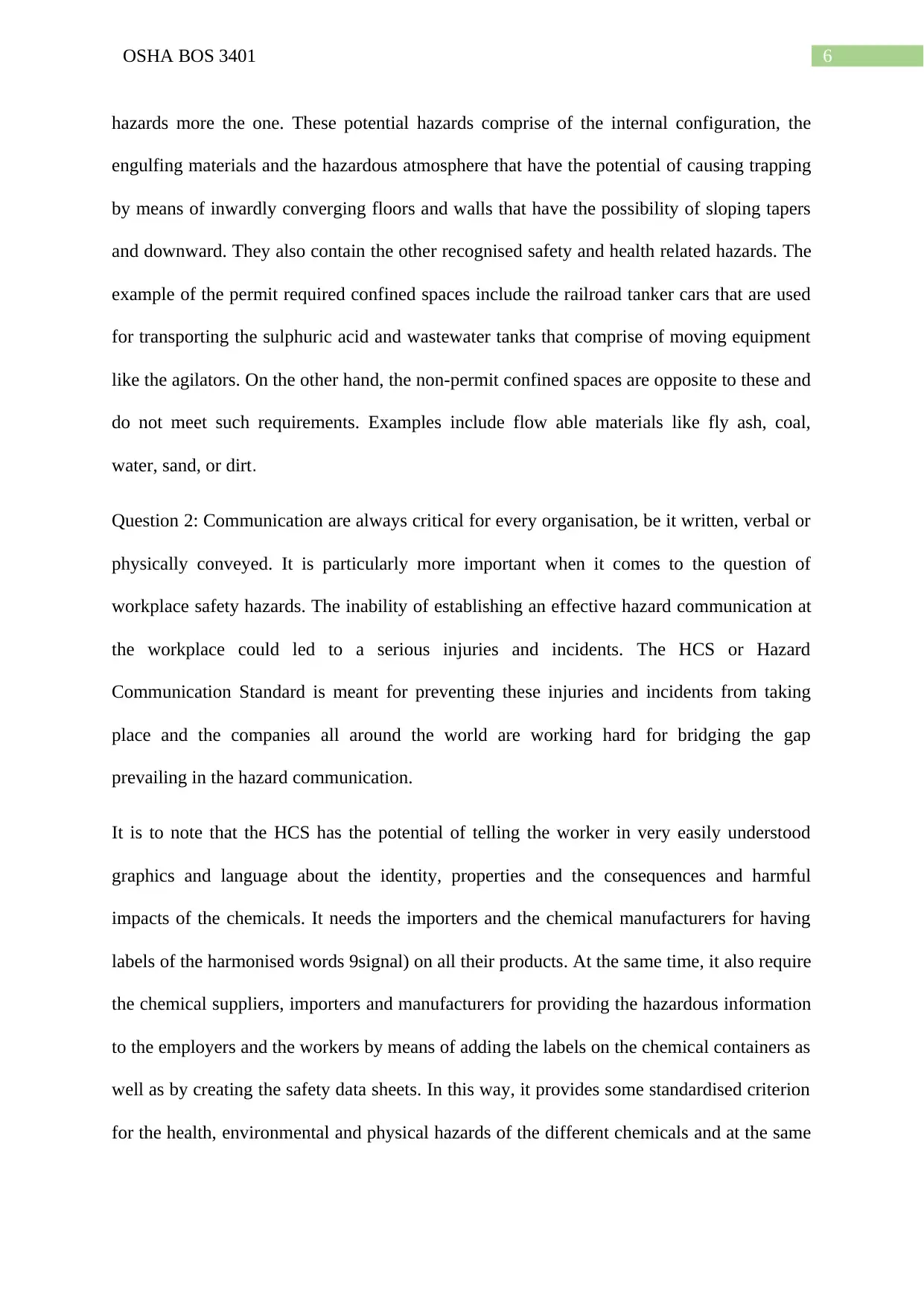
6OSHA BOS 3401
hazards more the one. These potential hazards comprise of the internal configuration, the
engulfing materials and the hazardous atmosphere that have the potential of causing trapping
by means of inwardly converging floors and walls that have the possibility of sloping tapers
and downward. They also contain the other recognised safety and health related hazards. The
example of the permit required confined spaces include the railroad tanker cars that are used
for transporting the sulphuric acid and wastewater tanks that comprise of moving equipment
like the agilators. On the other hand, the non-permit confined spaces are opposite to these and
do not meet such requirements. Examples include flow able materials like fly ash, coal,
water, sand, or dirt.
Question 2: Communication are always critical for every organisation, be it written, verbal or
physically conveyed. It is particularly more important when it comes to the question of
workplace safety hazards. The inability of establishing an effective hazard communication at
the workplace could led to a serious injuries and incidents. The HCS or Hazard
Communication Standard is meant for preventing these injuries and incidents from taking
place and the companies all around the world are working hard for bridging the gap
prevailing in the hazard communication.
It is to note that the HCS has the potential of telling the worker in very easily understood
graphics and language about the identity, properties and the consequences and harmful
impacts of the chemicals. It needs the importers and the chemical manufacturers for having
labels of the harmonised words 9signal) on all their products. At the same time, it also require
the chemical suppliers, importers and manufacturers for providing the hazardous information
to the employers and the workers by means of adding the labels on the chemical containers as
well as by creating the safety data sheets. In this way, it provides some standardised criterion
for the health, environmental and physical hazards of the different chemicals and at the same
hazards more the one. These potential hazards comprise of the internal configuration, the
engulfing materials and the hazardous atmosphere that have the potential of causing trapping
by means of inwardly converging floors and walls that have the possibility of sloping tapers
and downward. They also contain the other recognised safety and health related hazards. The
example of the permit required confined spaces include the railroad tanker cars that are used
for transporting the sulphuric acid and wastewater tanks that comprise of moving equipment
like the agilators. On the other hand, the non-permit confined spaces are opposite to these and
do not meet such requirements. Examples include flow able materials like fly ash, coal,
water, sand, or dirt.
Question 2: Communication are always critical for every organisation, be it written, verbal or
physically conveyed. It is particularly more important when it comes to the question of
workplace safety hazards. The inability of establishing an effective hazard communication at
the workplace could led to a serious injuries and incidents. The HCS or Hazard
Communication Standard is meant for preventing these injuries and incidents from taking
place and the companies all around the world are working hard for bridging the gap
prevailing in the hazard communication.
It is to note that the HCS has the potential of telling the worker in very easily understood
graphics and language about the identity, properties and the consequences and harmful
impacts of the chemicals. It needs the importers and the chemical manufacturers for having
labels of the harmonised words 9signal) on all their products. At the same time, it also require
the chemical suppliers, importers and manufacturers for providing the hazardous information
to the employers and the workers by means of adding the labels on the chemical containers as
well as by creating the safety data sheets. In this way, it provides some standardised criterion
for the health, environmental and physical hazards of the different chemicals and at the same
Paraphrase This Document
Need a fresh take? Get an instant paraphrase of this document with our AI Paraphraser

7OSHA BOS 3401
time, also standardises the approach for labelling the elements and preparing the safety data
sheets with the workers.
time, also standardises the approach for labelling the elements and preparing the safety data
sheets with the workers.
1 out of 8
Related Documents
Your All-in-One AI-Powered Toolkit for Academic Success.
+13062052269
info@desklib.com
Available 24*7 on WhatsApp / Email
![[object Object]](/_next/static/media/star-bottom.7253800d.svg)
Unlock your academic potential
© 2024 | Zucol Services PVT LTD | All rights reserved.


